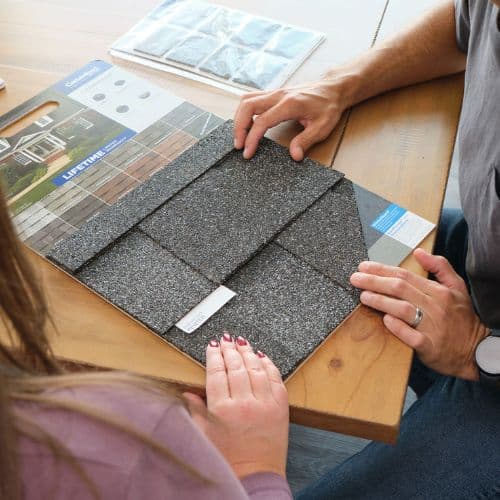Actual Cash Value vs. Replacement Cost Value: How to Get Insurance to Pay for Roof Replacement
If your roof is damaged, figuring out how to get insurance to pay for roof replacement can be stressful. At Wright at Home Roofing & Exteriors, we understand how confusing the terms Actual Cash Value (ACV) and Replacement Cost Value (RCV) can be. Let’s break them down in simpler terms and share some tips to help you get your insurance to pay for your roof replacement.
What is Actual Cash Value (ACV)?
ACV is the amount your insurance will pay to replace your roof, minus depreciation. Depreciation takes into account the age and wear of your roof. So, if your roof is older, the payout will be lower.
For example, if your 10-year-old roof costs $10,000 to replace but has depreciated by 50%, your insurer might only cover $5,000. You’ll have to cover the remaining cost.
While ACV policies often have lower premiums, they may not provide enough to fully replace an older roof.
What is Replacement Cost Value (RCV)?
RCV is much more straightforward. With an RCV policy, your insurer will pay the full cost to replace your roof without factoring in depreciation (aside from your deductible). So, if your roof needs replacing and it costs $10,000, they’ll cover that entire amount.
RCV policies typically come with higher premiums, but they offer peace of mind knowing your roof will be fully replaced, even if it’s older.

Tips for a Smooth Claim Process
To make sure your insurance covers your loss properly, follow these steps:
- Review Your Coverage: Before you do anything, take a moment to understand your insurance policy. Does it cover roof replacement? Is your policy based on ACV or RCV? Knowing the details of your coverage will help you prepare for the claims process and avoid surprises. For more on how to read your homeowner’s insurance policy, check out this helpful guide.
- Document the Damage: Once you notice roof damage, take clear photos and videos of everything. Capture wide shots for context and close-ups to highlight specific areas of damage. This visual evidence will play a crucial role in supporting your claim. Don’t forget to document any other areas of your home affected by the roof damage, as this can help provide a complete picture.
- Get a Professional Inspection: Before you submit your claim, hire a licensed roofing contractor to inspect the damage. They’ll provide a detailed report that outlines the extent of the damage and gives an expert opinion on the cost of repairs or replacement. This professional insight is important for ensuring the insurance company understands the full scope of the issue.
- File Your Claim Quickly: Insurance companies typically have a window of time for submitting claims after damage occurs, so it’s important to act fast. Contact your insurer as soon as possible to report the damage and file the claim. The quicker you file, the less likely it is that any issues (such as damage worsening over time) will affect your coverage.
- Check the Insurance Estimate: Insurance companies will send an adjuster to assess the damage and determine the payout. Once you receive the estimate, review it carefully. Often, estimates may leave out key elements like overhead costs, profit, or the full scope of repairs. If anything’s missing or seems incomplete, work with your roofer to supplement the estimate with additional details or adjustments. This step is key to ensuring that your insurance payout fully covers the cost of the replacement.
- Replace the Roof: After receiving your approval, your roofer will move forward with replacing the roof according to the insurance estimate. For ACV policies, the insurance payout will be less the deductible, and the roofer will apply that amount toward the cost of the replacement. For RCV policies, the insurer will first send you an ACV payment as a deposit, and once the roof is fully replaced, they’ll send a second check to cover the recoverable depreciation minus your deductible.
- Final Payment: Once the roof is replaced, your contractor will submit photos to the insurance company for a final review. If everything meets the approved scope of work, the insurer will issue a second payment to cover any recoverable depreciation. If you’ve already paid your roofer in full, you’ll get to keep the check. Otherwise, the second payment will go toward covering the remaining balance.

Final Thoughts
Understanding the difference between ACV and RCV is crucial when filing a roof replacement claim. While ACV can save you money on premiums, it may not cover the full replacement cost, especially for an older roof. RCV policies offer better coverage, though they come with higher premiums. Knowing your coverage and following these steps will help you get the most out of your claim.
If you need help navigating the insurance process, Wright at Home Roofing & Exteriors is here for homeowners in the Minneapolis metro. We’ve got the experience to guide you through the claim and make sure you get the coverage you deserve. Contact us today for a free consultation!

* NOTE: Wright at Home Roofing & Exteriors and its authorized representatives are NOT acting as Public Insurance Adjusters and will not negotiate with insurance on the Customer’s behalf. This blog is intended for informational purposes only and should not be construed as professional insurance advice. The information provided here is based on general knowledge and experience with roof replacement claims. For specific advice related to your insurance policy or claim, please consult with your insurance provider or a licensed insurance professional.



